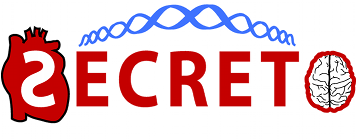Facts about cryptogenic stroke
What is a stroke?
Stroke is caused by an interruption of the blood supply to the brain, usually because blood vessel is blocked by a clot (ischemic stroke) or vessel bursts (intracerebral hemorrhage).
![]()
This cuts off the supply of oxygen and nutrients, causing damage to the brain tissue and cell death. The effects of a stroke depend on which part of the brain is injured and how severely it is affected. The most common symptom of a stroke is sudden weakness or numbness of the face, arm or leg, most often on one side of the body. Other symptoms may include, among others, difficulty speaking or understanding speech, visual disturbance, problems with walking, dizziness, loss of balance, fainting or unconsciousness.
Burden of stroke among young people
Global burden of stroke is considerable; every year approximately 15 million people suffer from a stroke and it is the second most frequent cause of death worldwide. Approximately 1 out of 10 strokes occur at age of less than 50 years, i.e. young-onset stroke, and the incidence is still increasing in both American and European populations due to yet unknown reasons. Although young stroke patients recover better compared to older patients, early-onset stroke can lead to more long-standing burden of both cardiovascular and neuropsychological illness. Moreover, young stroke patient face a four-fold risk of dying in the long-term after their stroke. Thus the demand of accurate diagnostic work-up and treatment is evident.
Risk factors and causes
The most common risk factors for ischemic stroke are high blood pressure, hypercholesterolemia, smoking, atrial fibrillation, diabetes mellitus and obesity. However, some risk factors are only present with young stroke patients, such as pregnancy or postpartum period, and contraceptive use.
Other risk factors, which are less well documented, may influence stroke risk at younger patients, including migraine with aura, infections, and patent foramen ovale. However, their exact role as a risk factor remain unclear and they all are very common in the population.
While the most common causes of ischemic stroke in the elderly include atherosclerosis, atrial fibrillation, and small vessel disease, in young stroke patients these causes are much less frequent. Instead, other causes seen relatively often in young-onset strokes include dissection of a neck artery, inflammation in the arterial wall, systemic diseases, hematologic conditions, and a number of monogenic diseases and syndromes.
Diagnostic workup
The thorough work-up especially in young patients without apparent cause for the stroke should include, besides careful clinical examination, brain magnetic resonance imaging, imaging of head and neck arteries, prolonged ECG-monitoring, and cardiac ultrasound.

This is a major problem, since there are very scant data on how to prevent subsequent strokes and other vascular events in such circumstances for years to come.
SECRETO study
SECRETO study aims to provide novel information on stroke mechanisms and prognosis of cryptogenic young-onset ischemic strokes. Patients aged 18-49 years, hospitalized due to first-ever imaging-positive stroke of undetermined etiology, are enrolled, examined according to a standardized protocol, and followed for ten years. Age- and sex-matched stroke-free controls will be searched for each patient to allow identification of new risk factors. We believe SECRETO will likely result in scientific breakthroughs by establishing novel causes for cryptogenic ischemic stroke and provide new directions for therapy development in these patients.
Both transthoracic and transesophageal ultrasound should be performed to allow good visualization of left atrium of the heart and the wall between left and right atrium. So-called transcranial Doppler ultrasound can be used to screen or verify shunts in the circulation, e.g. between right and left cardiac atriums. Also routine blood test should be taken, including tests for familial prothrombotic disorders.




